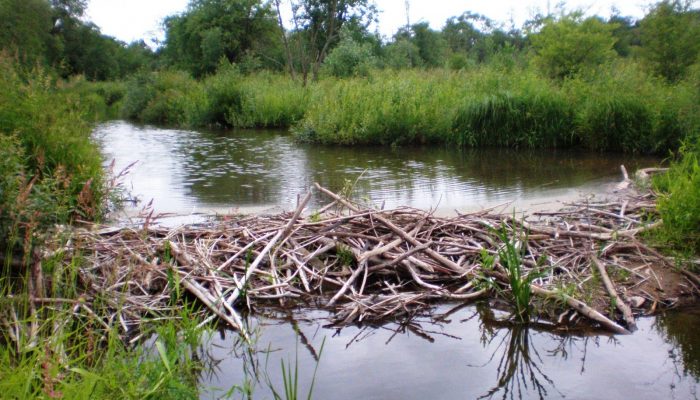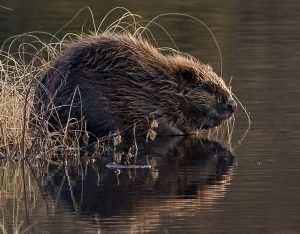
Following her presentation at the European Geosciences Union General Assembly in Vienna, I caught up with geomorphologist and environmental detective Annegret Larsen from the University of Lausanne, Switzerland, about beavers, baffling sediments and a case she’s been solving for the past seven years.
Back in 2012 the German geomorphology community was seriously debating the source of buried black soils, a stark black layer of sediment found in floodplain deposits all over Europe. Such dark sediments are usually associated with organic, carbon-rich materials, like peat. But unlike the other dark deposits, these soils are low in organic carbon, leading to a wide spectrum of ideas about their origin.
“They’re almost everywhere, and many people have had big fights about them and where they come from. Fire might have played a role, or human impact, or a rising water table associated with changes in climate,” explains Larsen.
The soils themselves are quite variable. Some deposits are quite muddy, while some trap fragments of long-dead plants. “They look a little like the relic of a swamp, containing grassy vegetation, sticks, leaves and little nuts, and they’re mainly black,” said Larsen. At the University of Lausanne, Switzerland and the University of Manchester, UK, she and her colleagues have been studying the composition and chemistry of black soils in an effort to understand how they formed.
Recently, Larsen has uncovered a possible connection between the black soil deposits and European beaver habitats. She presented her findings at the annual EGU meeting earlier this month.

The accused: a European beaver. Credit: Per Harald Olson via Wikimedia Commons
The idea began to take shape while Larsen was driving within the Spessart region of Switzerland. During her travels, she had found the soil situated in environments where beaver populations had been dwelling for some 25 years.
“There are huge swamps, what we call beaver meadows. And the vegetation communities are just like the ones found in those deposits,” said Larsen.
This discovery led her to develop a field experiment with the aim to determine whether beavers could be responsible for these puzzling black deposits.
“It’s like a big mystery for me. To find out if the black floodplain soil really come from when there was a widespread beaver population, before humans eradicated the beaver, I need to understand what the beaver does nowadays, and that’s how I started the project.”
Larsen thinks the beaver-created landscapes change with age, and she has been keeping a close watch on four sites across Switzerland and Germany, where beaver communities have been established for up to 25 years.
The long-toothed mammals have striking impacts on the landscape, which differ depending on where they build their dam. Upstream architecture results in beaver cascades, a series of closely packed ponds, each separated by a beaver dam. Down river, efforts go into one ‘megadam’ that stretches across a slow, meandering section of the stream and cause it to spill out into a large swampy floodplain.
The cascades, Larsen describes, are pretty dynamic. “Sediment gets trapped behind each dam, then they get strained, breach and break, causing sediment to flush downstream. It’s collected by the next dam and that then overtops and then that breaks” and the process starts all over again.
Beaver meadows begin as large expanses of water, ponds teeming with semi-aquatic vegetation. Over time, fine sediment gathers in the ponds. As the sediment builds up, the area becomes a swamp – a patchwork of shrubs, trees, running water and tough, grassy plants. “You definitely get an explosion in diversity, but it’s a complete change, the area becomes a wetland,” adds Larsen.
And the wetland contains plants that resemble those found in the buried floodplain soils.
“For me, it’s fascinating to think about how all our streams would have looked with a beaver in there: before humans impacted those streams, before humans eradicated the beaver, and before [humans] settled there. There must have been beavers everywhere. Every stream would have been a beaver stream. And a beaver stream looks totally different [to what we see today].”
With the deposits all over Europe, it isn’t hard to imagine that, in years past, beavers shaped the streams, swamps and landscapes of the continent. It’s feasible that these regions might have been swampy landscapes at one point in history.
So, are the beavers behind the black soils? “I think we’re on a good path to contribute to this discussion. It’s at least as reasonable as fire and climate,” she replies.
Larsen makes a strong case, but the jury, it seems, is still out.
By Sara Mynott, EGU Press Assistant






Jonathan Spencer MBE
Having seen what the newly arrived beavers have achieved in various locations in England I find this a highly plausible origin for black soil horizons on floodplains. We have fossil beavers dams and lodges along the Kennet in Berkshire and a famous lodge ( that held a fossil beaver inside it!) on the Thames at Eton near Windsor. I imagine it highly likely that the black soils will also have fossil beaver dams in situ at some locations. JWS
Robert Ondrak
Interesting article but where is the Spessart region in Switzerland located?
I only know the Spessart in the North of Bavaria and reaching into Hesse